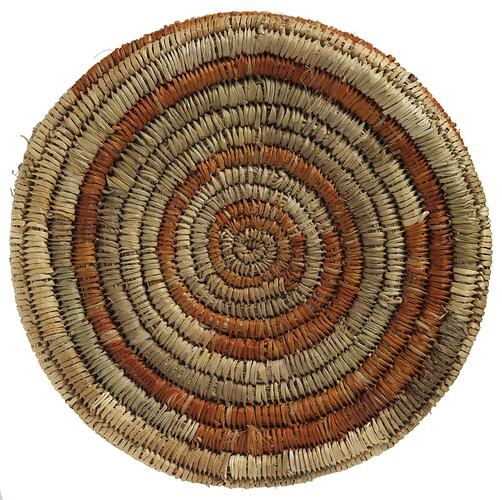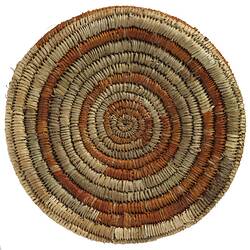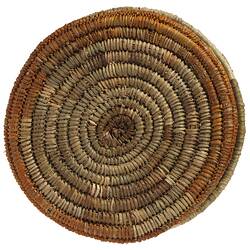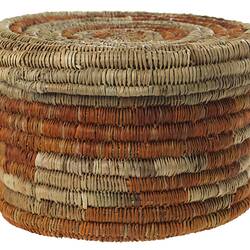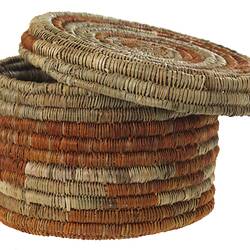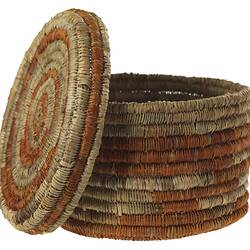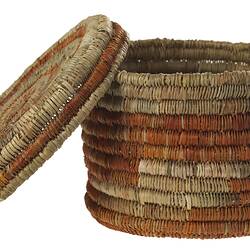Summary
This koyi (basket) represents the entwining of two culturally distinct regions: the south-east of Australia and Arnhem Land. Made by Elder Aunty Letty Nicholls, it is the result of a workshop and exhibition entitled 'Twined Together', held at Melbourne Museum in 2003. As part of this landmark exhibition weavers from south-eastern Australia and Arnhem Land spent a week sharing techniques, knowledge and stories. This cross-cultural exchange of information resulted in the creation of many beautiful new works, such as this koyi, as well as ongoing relationships between the artists from these disparate communities.
Aunty Letty brought sedge grass collected from her Country, along the Murray River. She watched the women from Arnhem Land place their grasses in a flour drum filled with boiling water and dye, a technique not used by weavers from the south-east. Placing her rushes into the dye, the result was a rich copper-coloured fibre that she later worked into this basket.
Local Name
Koyi
Physical Description
Lidded basket; dyed and undyed sedge grass, circular. Contains lid with sides about 30mm long. Alternate mix of rows with dyed orange and undyed grass.
Significance
Aunty Lettie is a weaver and feather-flower maker who belongs to a family known for their skills in these arts. Her mother, Emma Karpany, was famous for her pine-needle work. Emma Karpany (1912-1988) was a Ngarrindjeri woman from Tatiara, in South Australia. She travelled north with her family and settled by the Murray River near Swan Hill in Victoria in an attempt to prevent her children being taken by South Australian government officers who posed an ever-present threat. Using traditional practices, Emma (also known as Emily) would make koyi (baskets) and demonstrate weaving at town events to supplement the family income. Just as Emma Karpany passed on her weaving skills, Aunty Lettie Nicholl's daughters are also highly-skilled weavers and craftswomen celebrated for their creations. Her daughter, Glenda Nicholls, is a renowned artist and curator who speaks of the power of handing down cultural techniques that have been in use for thousands of generations:
'And so, now the storylines continue and the passing of weaving and craft knowledge is carried into future generations in a contemporary way. We still consult, counsel and acknowledge, not only each other but also our ancestors, promoting self-esteem, pride and acknowledgement of different and yet the same practices within our cultures before, now, and into the future.' Glenda Nicholls, 2017.
References
Nicholls, G. 2017, Weaving the Waterways: Women and Fishing - weaving a connection of rover-life, from the Murray to the Birrarung, p. 6, Koorie Heritage Trust
More Information
-
Object/Medium
Basket
-
Maker
-
Cultural Groups
-
Locality
-
Date Produced
-
Fully Extended
200 mm (Length), 200 mm (Width), 127 mm (Height), 200 mm (Outside Diameter)
-
Classification
-
Date Made
-
Maker
-
Clan/Language Group
-
Place Made
-
Indigenous Region
-
Type of item
-
Discipline
-
Category
-
Collecting Areas
